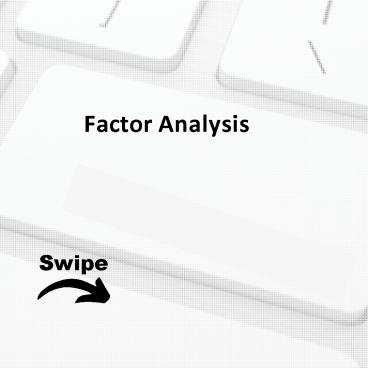Factor Analysis - PowerPoint PPT Presentation
Title:
Factor Analysis
Description:
This presentation educates you about Factor Analysis, Types of Factoring, Assumptions, Key concept and terms and Two approaches CFA. For more topics stay tuned with Learnbay. – PowerPoint PPT presentation
Number of Views:10
Title: Factor Analysis
1
Factor Analysis
Swipe
2
Factor Analysis
Factor analysis is used to uncover the latent
structure of a set of variables. It reduces
attribute space from a large number of variables
to a smaller number of factors and as such is a
non dependent procedure.
3
Types of Factoring
Principal component analysis Common factor
analysis Image factoring Maximum likelihood
method Factor loading Eigenvalues Factor
score Criteria for determining the number of
factors Rotation method
4
Assumptions
No outlier Assume that there are no outliers in
data. Adequate sample size The case must be
greater than the factor. No perfect
multicollinearity Factor analysis is an
interdependency technique. There should not be
perfect multicollinearity between the variables.
5
Homoscedasticity Since factor analysis is a
linear function of measured variables, it does
not require homoscedasticity between the
variables. Linearity Factor analysis is also
based on linearity assumption. Non-linear
variables can also be used. After transfer,
however, it changes into linear
variable. Interval Data Interval data are
assumed.
6
Key concepts and terms
E xploratory factor analysis Assume that
any indicator or variable may be associated with
any factor. This is the most common factor
analysis used by researchers and it is not based
on any prior theory. C onfirmatory factor
analysis (CFA) Used to determine the factor and
factor loading of measured variables, and to
confirm what is expected on the basic or
pre-established theory. CFA assumes that each
factor is associated with a specified subset of
measured variables.
7
Two approaches CFA
- The traditional method Traditional factor method
is based on principal factor analysis method - rather than common factor analysis. Traditional
method allows the researcher to know more - about insight factor loading.
- The SEM approach CFA is an alternative approach
of factor analysis which can be done in SEM. In
SEM, we will remove all straight arrows from the - latent variable, and add only that arrow which
has to observe the variable representing the
covariance between every pair of latents.
8
Topics for next Post
Linear Regression Association Rule hierarchical
clustering Stay Tuned with

